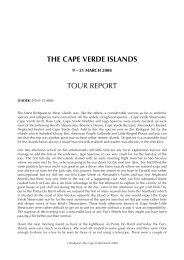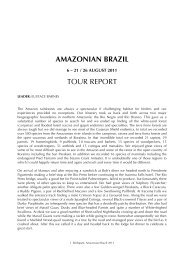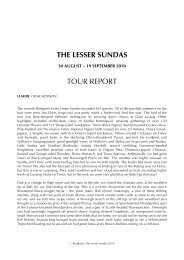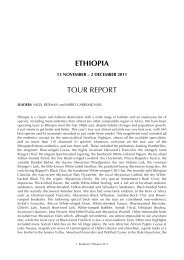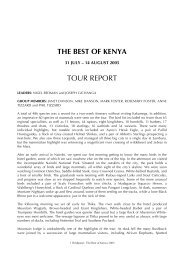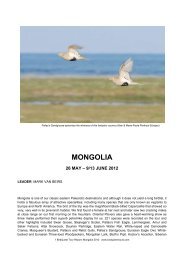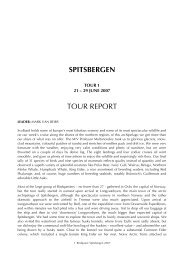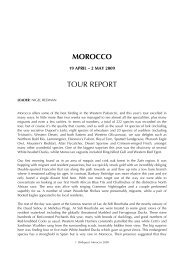Download Full Tour Report 1202kb - Birdquest
Download Full Tour Report 1202kb - Birdquest
Download Full Tour Report 1202kb - Birdquest
You also want an ePaper? Increase the reach of your titles
YUMPU automatically turns print PDFs into web optimized ePapers that Google loves.
GRALLARIIDAE<br />
Scaled Antpitta Grallaria guatimalensis (H): Always too distant for even a lucky break. Genetic data<br />
call for Grallaria to be placed in its own family, separate from Formicarius and<br />
Chamaeza.<br />
White-throated Antpitta Grallaria albigula (H): One bird was heard-only in rank undergrowth at<br />
middle elevations in the cloud forest.<br />
Red-and-white Antpitta Grallaria erythroleuca: A good sighting for Richard and also seen by Michael<br />
but the rest struggled to see this bird in the bamboo.<br />
Rufous Antpitta Grallaria rufula (H): We heard one in deep cover which proved impossible to see,<br />
here the race occabambae.<br />
Amazonian Antpitta Hylopezus berlepschi: This species eventually showed quite well at Amazonía<br />
Lodge on our first morning there. We all had to do a bit of body-contorting but amazingly<br />
the bird just stood there for the longest time which we were very grateful for. Named for<br />
Hans Hermann Carl Ludwig Von Berlepsch (1850-1915), a German ornithologist who<br />
sponsored several expeditions to South America.<br />
Thrush-like Antpitta Myrmothera campanisona (H): At Amazonía Lodge this one was always too far<br />
or too deep!<br />
CONOPOPHAGIDAE<br />
Slaty Gnateater Conopophaga ardesiaca: We saw a pair of this skulker very well in the cloud forest<br />
understory.<br />
RHINOCRYPTIDAE<br />
Rusty-belted Tapaculo Liosceles thoracicus: One individual was fairly obliging for most of us at<br />
Amazonía Lodge.<br />
Trilling Tapaculo (Grey T) Scytalopus parvirostris: Most of us had at least some sort of tickable view<br />
in the upper Manu cloud forest.<br />
White-crowned Tapaculo (Northern White-crowned T) Scytalopus atratus: One sighting above Cockof-the-Rock<br />
Lodge which most of us managed to see. Recent analysis has shown that<br />
Manu birds are more closely allied to the Northern White-crowned rather than Bolivian<br />
(Southern White-crowned T) birds, S. bolivianus, which occur north only to Puno.<br />
However, look for the northern birds to be further split once their relationships are better<br />
understood (a real taxonomic conundrum).<br />
TYRANNIDAE<br />
Sclater's Tyrannulet Phyllomyias sclateri: Good views of up to six individuals in the forest below<br />
Machu Picchu during the extension.<br />
Ashy-headed Tyrannulet Phyllomyias cinereiceps: We did quite well with this species towards the<br />
end of our birding at Aguas Calientes.<br />
Yellow-crowned Tyrannulet Tyrannulus elatus: A few sightings at Amazonía Lodge and the Manu<br />
lowlands.<br />
Forest Elaenia Myiopagis gaimardii: Common by voice, with at least 4 sightings between Romero and<br />
Manu Wildlife Centre.<br />
Large Elaenia Elaenia spectabilis: We all had good views in the scope of this austral migrant at our<br />
lunch stop en route to Amazonía.<br />
White-crested Elaenia Elaenia albiceps: Several were seen well at Huacarpay Lake, here either the<br />
coastal modesta or the more local urubambensis.<br />
Mottle-backed Elaenia Elaenia gigas: Good views of one bird on the shores of the upper Madre de<br />
Dios.<br />
Highland Elaenia Elaenia obscura: One individual of this species was seen in the Manu temperate<br />
forest where it is a rather uncommon bird.<br />
Sierran Elaenia Elaenia pallatangae: Fairly common at upper elevations, here the race intensa.<br />
30 <strong>Birdquest</strong>: The Manu 20011




